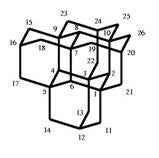Modeling Nanoporous Carbons

Adamantane-like vacancy cluster

Non-adamantane-like vacancy cluster with the surrounding atoms and on without the surrounding atoms. The right: atoms surrounding the vacancy cluster in their relaxed positions.
With the recent development in the production of porous carbons with controllable pore sizes the following basic question arises: what are the stable pore sizes and shapes in porous carbons on the nanoscale? The size and shape of pores have a profound effect on the energetics of adsorptive storage, a problem of great potential technological importance. The problem of modeling missing groups of atoms –vacancy clusters—have received considerable attention in silicon, providing a basis of comparison for similar work in diamond. Surprisingly, the experimental study of vacancy clusters in diamond has been started only recently and their theoretical research is only on a speculative level. Due to the rich chemistry of carbon with its unique energetics of the close lying sp, sp 2, and sp 3 hybridized states as opposed to the typically sp 3 hybridized silicon suggests that stable carbon vacancy clusters might display a dazzling variety of shapes and sizes. Indeed, much of this work in modeling vacancy clusters beyond the size of a dozen or so vacancies centers on selecting representative samples from the astronomical number of combinatorially possible structures those thousands of structures for which actual calculations can been done. Our research in this area deals with the enumeration and identification of stable vacancy clusters using modern density functional theory. We are also looking for trends concerning the structures of the inner surfaces of the cavities. The long-term goal of this research is to aid our collaborating partners at Drexel University in their experimental work in designing porous carbons for gas storage and energy storage materials.
Selected references:
- “The [V-C=C-V] Divacancy and the Interstitial Defect in Diamond: Vibrational Properties” Hyde-Volpe, D.; Slepetz, B.; Kertesz M. J. Phys. Chem. C, 2010, 114, 9563-9567.
- “Simulations of Large Multi-atom Vacancies in Diamond“, Istvan Laszlo, Miklos Kertesz, Brad Slepetz, and Yury Gogotsi
Diamond Relat. Mater. 2010, 19, 1153-1162. - “Characterization of large vacancy clusters in diamond from a generational algorithm using tight binding density functional theory”, Slepetz, B.; Laszlo, I.; Gogotsi, Y.; Hyde-Volpe, D.; Kertesz, M. Phys. Chem. Chem. Phys. 2010, 12, 14017-14022.
